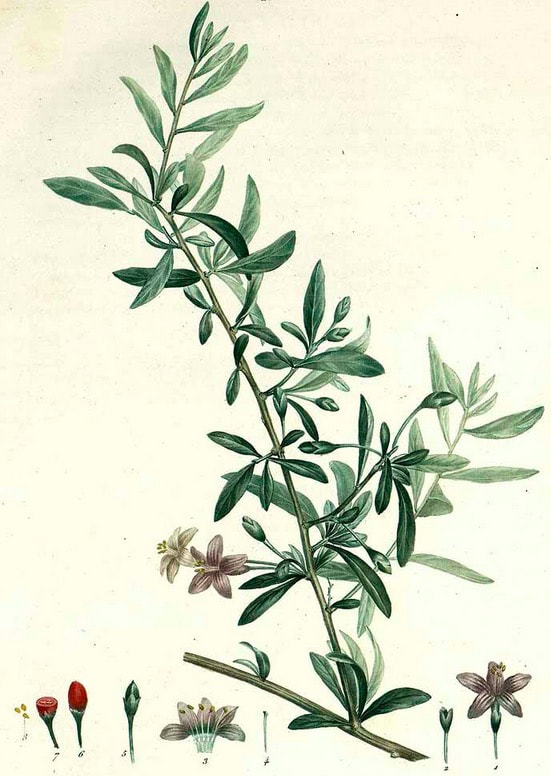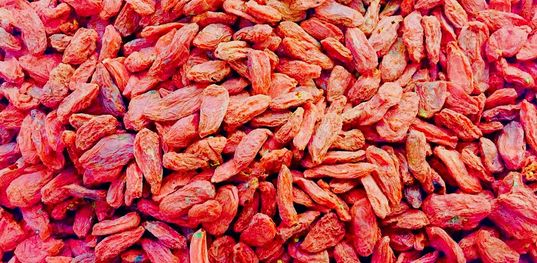Lycium Fructus, Gou Qi Zi 枸杞子
‘Goji'; Chinese Wolfberry
Gou Qi Zi (TCM)
Chirchita (Ayurveda)
'Dre tsher ma འདྲེ་ཚེར་མ་ (Tibet)
Gou Qi Zi (TCM)
Chirchita (Ayurveda)
'Dre tsher ma འདྲེ་ཚེར་མ་ (Tibet)
Lycium barbarum
Duhamel du Monceau, Traité des arbres et arbustes, Nouvelle édition 1800-1803
Duhamel du Monceau, Traité des arbres et arbustes, Nouvelle édition 1800-1803
Lycium Gou Qi (Adam, 2017)
Botanical name:
Lycium chinense, L. barbarum.
There are a number of Lycium species that supply the market.
Parts used:
Fruit
Temperature & Taste:
Neutral, slightly Moist. Sweet
Lycium chinense, L. barbarum.
There are a number of Lycium species that supply the market.
Parts used:
Fruit
Temperature & Taste:
Neutral, slightly Moist. Sweet
ADVERTISEMENT:
Uses:
1. Nourishes Kidney and Liver Yin: (TCM, Tibet)
-weakness and aching of the Lower Back and Legs
-Impotence, Spermatorrhea
-Diabetes-like disorders, Consumption
-Anemia
-used in formulas for Female diseases (TCM, Tibet)
2. Strengthens the Eyes: (TCM, Tibet)
-Poor Eyesight, Blurry Vision, Night-blindness
3. Benefits the Essence: (TCM, Tibet)
-Chronic Fatigue from Essence deficiency, premature Aging
-dullness of Mind and Spirit; Dizziness, Tinnitus
-it nourishes Yin and Blood while also helping nourish Yang and Essence when combined with suitable herbs.
4. Nourishes Lungs:
-chronic Cough, Consumption
Dose:
Decoction: 6–12 grams.
Often added to flower teas and soups in China.
Comment:
The root-bark of this plant is also used medicinally (see Lycium Cortex, Di Gu Pi)
Decoction: 6–12 grams.
Often added to flower teas and soups in China.
Comment:
The root-bark of this plant is also used medicinally (see Lycium Cortex, Di Gu Pi)
Main Combinations:
Lycium Gou Qi Zi and Chrysanthemum Ju Hua
This combination clears Heat from the Liver while simultaneously nourishing Liver Yin and Blood. It is useful to strengthen the Eyesight, as well as for Headache, Tinnitus and Deafness.
It is also taken as a tea by young women to keep the skin healthy and clean.
1. To strengthen the Vision, Blurred Vision, failing Eyesight:
i. Lycium Gou Qi Zi with ... available in PRO version
ii. Lycium Gou Qi Zi with ... available in PRO version
iii. chronic conditions with deficiency, ... available in PRO version
2. To nourish Kidney and Liver Yin, Lycium Gou Qi Zi with ... available in PRO version
-to Warm and strengthen the Yang, add ... available in PRO version
-add ... available in PRO version
-Infertility, anovulation, chronic anemia, add ... available in PRO version
-to more strongly nourish Yin and Essence, with ... available in PRO version
3. Lower Back and Leg pain and weakness from deficiency:
i. Lycium Gou Qi Zi with ... available in PRO version
ii. Lycium Gou Qi Zi with ... available in PRO version
4. Consumptive Cough, Lung Yin deficiency:
i. Lycium Gou Qi Zi with ... available in PRO version
ii. Lycium Gou Qi Zi with ... available in PRO version
5. Overexertion and Weakness of Yin, Lycium Gou Qi Zi with ... available in PRO version
6. To support during Chemotherapy: ... available in PRO version
Major Formulas:
Bu Shen Gu Chong Wan
Da Ying Jian
Gui Lu Er Xian Jiao
Jing Qian Fang
Nuan Gan Jian
Qi Bao Mei Ran Dan
Qi Ju Di Huang Wan
Yi Guan Wan
You Gui Wan
You Gui Yin
Zuo Gui Wan
Zuo Gui Yin
There are many food and tea recipes using Goji in China too:
1. Goji and Chrysanthemum tea, good for the skin, to prevent ageing and help the Liver.
2. Goji and Walnut Congee, to strengthen Kidneys, and for Winter
3. Goji and Lamb, a warming tonic recipe for Winter
4. Mushroom and Goji stir-fry
5. Goji and Corn Soup
6. Tonic Chicken Soup with Goji, Red Dates (Da Zao), Codonopsis Dang Shen and Dang Gui, a Blood and Qi tonic.
7. Cook Cordyceps with Duck, Chicken or Pork and Astragalus Huang Qi, Angelica Dang Gui and Lycium Gou Qi Zi.
ADVERTISEMENT:
Cautions:
1. Not used in Spleen deficiency with Dampness and Diarrhea
2. In Ayurveda, the Fruit and Root-bark are prohibited in Bleeding disorders.
Main Preparations used:
1. Not used in Spleen deficiency with Dampness and Diarrhea
2. In Ayurveda, the Fruit and Root-bark are prohibited in Bleeding disorders.
Main Preparations used:
Click the Tabs above for more information on this Medicine




